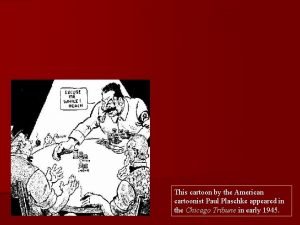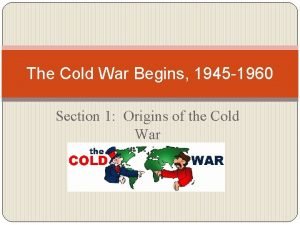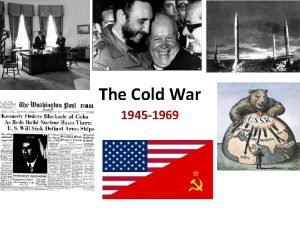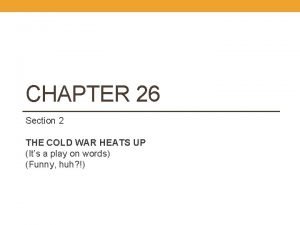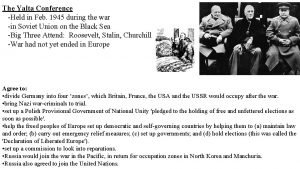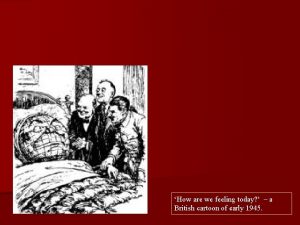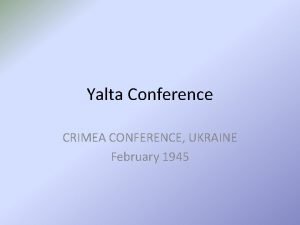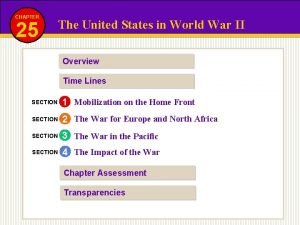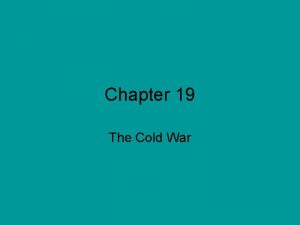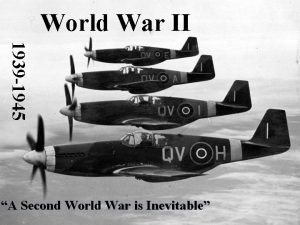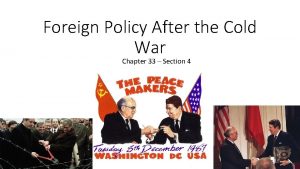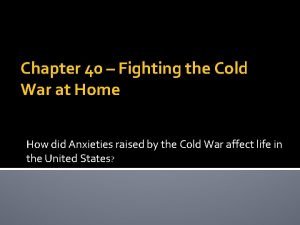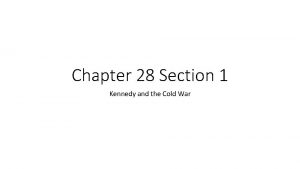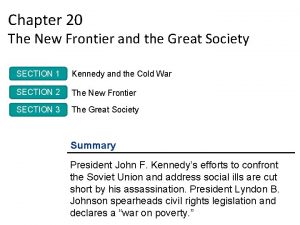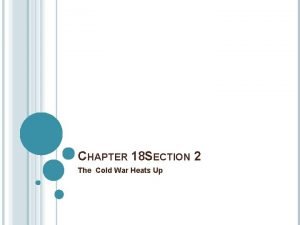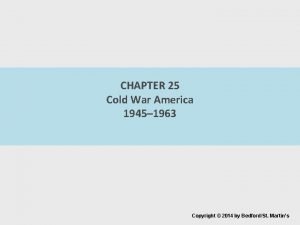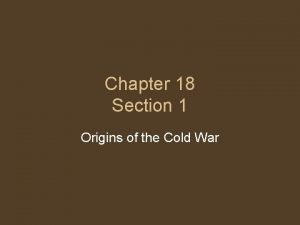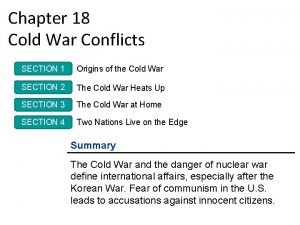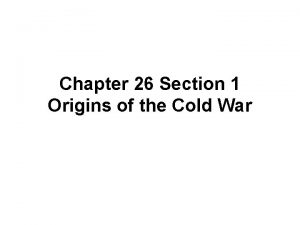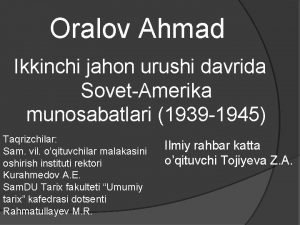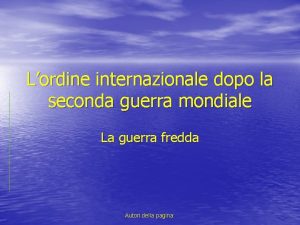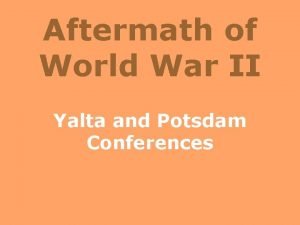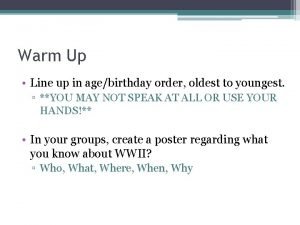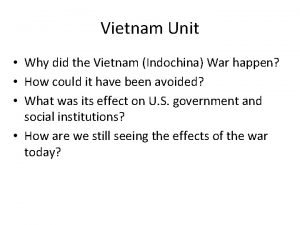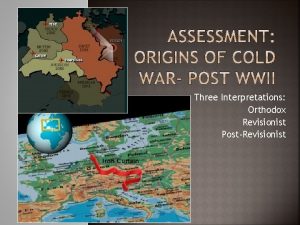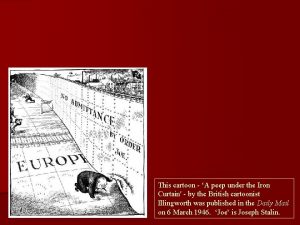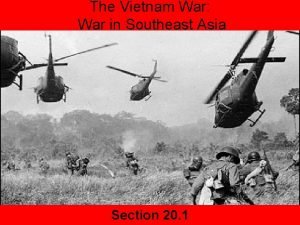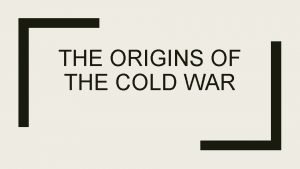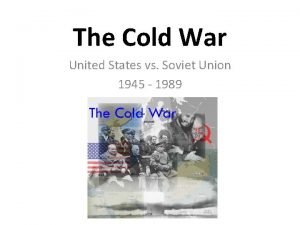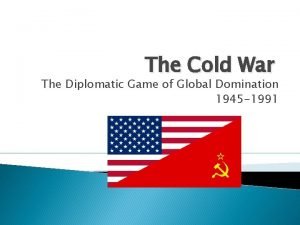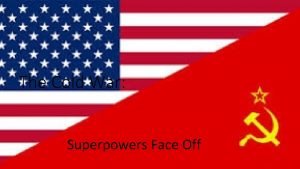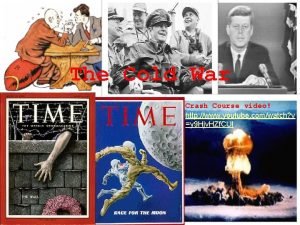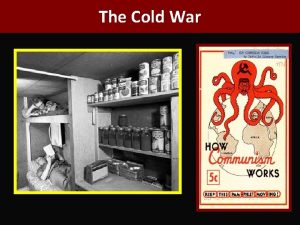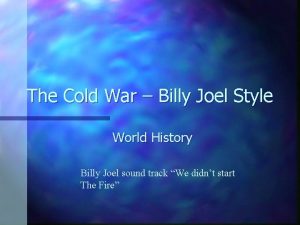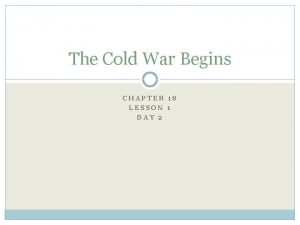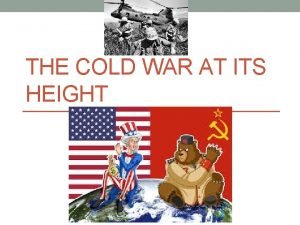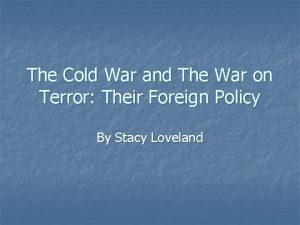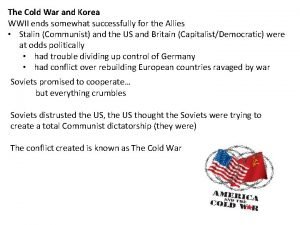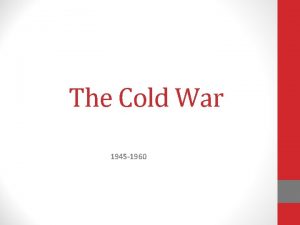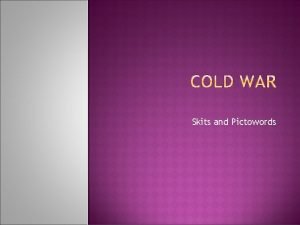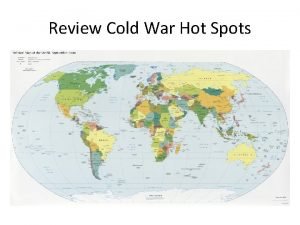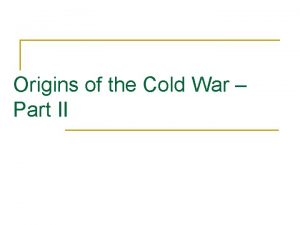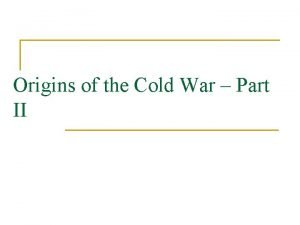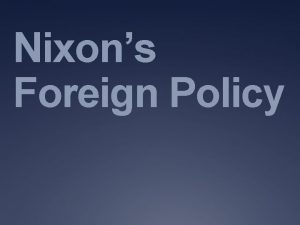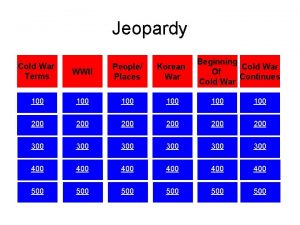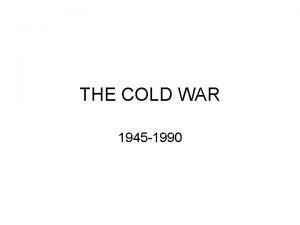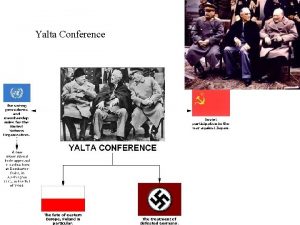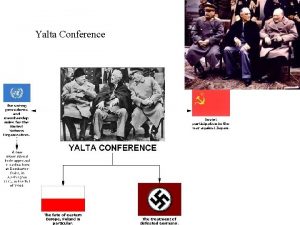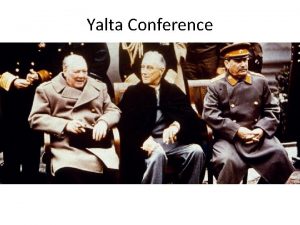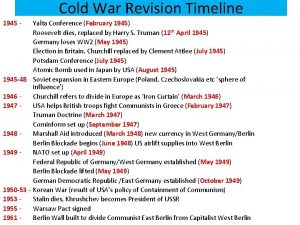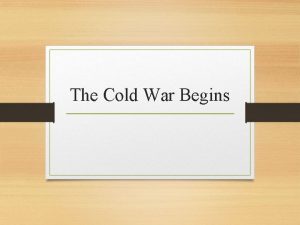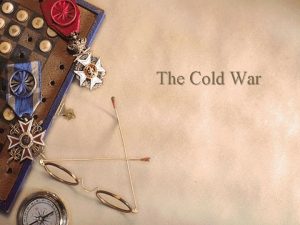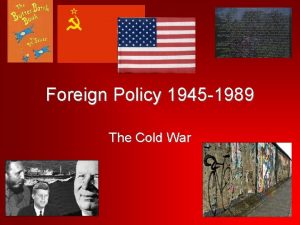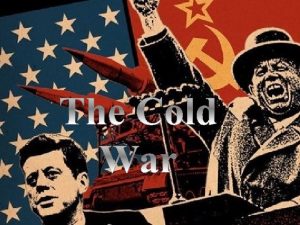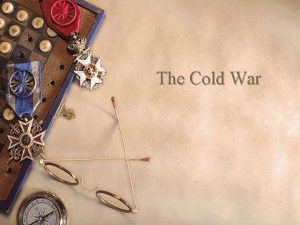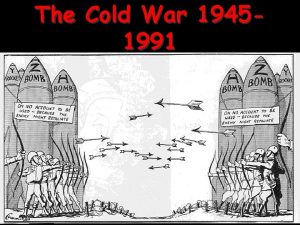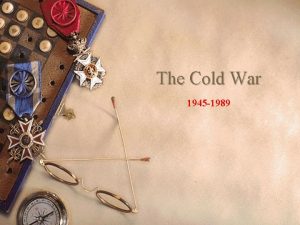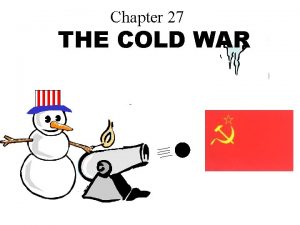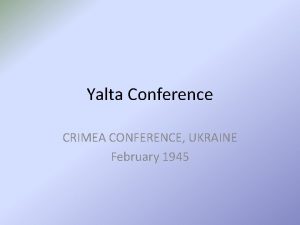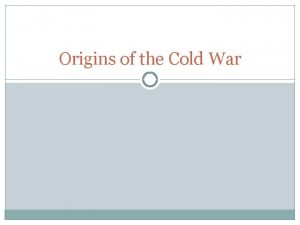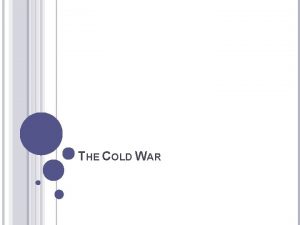Chapter 19 The Cold War 1945 Yalta Conference





















































- Slides: 53

Chapter 19 The Cold War

1945 Yalta Conference • • • BIG THREE, Roosevelt, Churchill, and Stalin made arrangements for postwar Europe at the Yalta Conference in February 1945. Their meeting resulted in many important resolutions: United Nations free elections in Poland (did not happen) The borders of Poland were to be drastically moved westwards, at the expense of Germany. The division of Germany was decided. The Soviet Union was to attack Japan within three months of Germany's surrender. Churchill, FDR, Stalin Division of Germany

United Nations formed • • UN officially came into existence on Oct. 24, 1945 50 countries meet, including U. S. Adopt charter of UN organization dedicated to cooperation in solving international problems.

Potsdam Conference • On April 12, 1945, Roosevelt died unexpectedly, making Vice President Truman the new President. Truman continued Roosevelt’s negotiations with Stalin at the Potsdam Conference in July. Big Three: Churchill, Truman, Stalin Clement Attlee replaced Churchill after he lost the election for prime minister in 1945 The Big Three met to decide how to govern Germany, which had been defeated nine weeks earlier and to discuss the establishment of post-war order, peace treaties issues, and countering the effects of war.

America and the USSR wanted different things for post-war Europe American Goals • Wanted European nations to be democratic and have economic opportunity like the United States • Wanted to develop strong capitalist economies, which would provide good markets for American products

Soviets’ conflicting goals Soviet Goals • Wanted to rebuild Europe to help the Soviet Union recover from the huge losses it suffered during the war • Wanted to establish Soviet satellite nations (buffer zone), countries subject to Soviet domination and sympathetic to Soviet goals • Wanted to promote the spread of communism throughout the world

Communist Expansion in Eastern Europe • Albania, Bulgaria, Czechoslovakia, Hungary, Romania, East Germany, Poland, and Yugoslavia Finland maintained independence by signing a treaty of cooperation with the Soviet Union.

The Iron Curtain. Churchill coined phrase Iron Curtain while making a speech in Missouri to describe the geographic and political divisions between Communist and capitalist nations in Europe Iron Curtain I have a strong admiration and regard for the valiant Russian people and for my wartime comrade, Marshal Stalin. There is deep sympathy and goodwill in Britain -- and I doubt not here also -- toward the peoples of all the Russias and a resolve to persevere through many differences and rebuffs in establishing lasting friendships. It is my duty, however, to place before you certain facts about the present position in Europe. From Stettin in the Baltic to Trieste in the Adriatic an iron curtain has descended across the Continent. –Winston Churchill March 6, 1946

Cold War- the competition between the United States and the Soviet Union for world influence that lasted from about 1947 until the collapse of the Soviet Union in 1991. Open hostilities never occurred between the United States and the USSR. Instead, the “war” was an arms race, a network of military alliances, economic warfare, embargos, propaganda, and espionage

Containment • Policy laid out by George F. Kennan • Stop the spread of communism • Truman Doctrine designed to put policy in place The Truman Doctrine- foreign policy of the U. S. announced by President Truman in March, 1947, that the U. S. would support free peoples that resist conquest. It was used first in Greece and Turkey with economic ($400 million) and military aid to prevent their falling to the Soviet. Many historians say this marks the beginning of the Cold War.

Which of these choices best describes the primary goal of the United States for postwar Europe? (A) Protect the Soviet Union from future invasion (B) Build economically strong democracies (C) Add more members to the United Nations (D) Ensure further cooperation with Stalin Which of these events directly inspired the Truman Doctrine? (A) Soviet threats in Greece and Turkey (B) The division of Germany into four zones (C) The arrest of anti-Communist leaders in Hungary (D) Churchill’s “iron curtain” speech

Section 2

Marshall Plan • Created in 1947 by Sec. of State George C. Marshall • Help European nations recover from WWII and become economically strong democracies • Prevent communism from continuing to gain power in Europe • Nations with recovery plans would receive money from the U. S. • 17 western European nations received $13 billion in aid

Marshall Plan in Germany Workers are busy at a construction site in Berlin, Germany, financed with American money supplied by the Marshall Plan. Between 1948 and 1951, the Marshall Plan funneled $13 billion into European recovery.


Berlin Airlift • In June 1948, Stalin banned all shipments to West Berlin through East Germany, creating a blockade which threatened to cut off supplies to the city and starve its people. • In response, Allied nations delivered thousands of tons of food and other supplies to West Berlin by air. • Airlift lasted 462 days; nicknamed Operation Vittles; • Airplanes nicknamed raisin bombers • 278, 228 flights were made and 2, 326, 406 tons of food and supplies, including more than 1. 5 million tons of coal, were delivered to Berlin. • Soviet blockade ended in May 1949, as a result of the airlift

At the height of the operation, on April 16, 1949, an allied aircraft landed in Berlin every minute, with 1, 398 flights in 24 hours carrying 12, 940 tons of goods, coal and machinery, beating the record of 8, 246 set only days earlier.

NATO and the Warsaw Pact • The North Atlantic Treaty Organization -formed in April 1949. • Little conflict was being resolved in the United Nations because the Soviets used their veto power in the Security Council to block many proposals • The United States, Canada, and ten Western European nations pledged to support one another against attack, a principle known as collective security. • In response, the Soviet Union created the Warsaw Pact, a military alliance between the Soviet Union and its satellite nations.

The Soviets Get the Bomb! • In September 1949, the Soviet Union tested an atomic bomb. • In response, the United States began developing the hydrogen bomb • The newly formed Federal Civil Defense Administration distributed information on how to survive a nuclear attack; this information was ridiculed by experts. Nuclear air raid drills were part of everyday life for schoolchildren in the late 1940 s and early '50 s. Children were taught to "duck and cover" under their desks and were herded into school basements for periodic air raid drills.

Bomb Shelters

China Falls to Communism • During World War II, Jiang Jieshi (Chiang Kai Shek)and Mao Zedong had worked together to fight the Japanese, but fighting between them resumed towards the end of the war. • The United States supported Nationalist leader Jiang Jieshi against Communist Mao Zedong, even though Jiang Jieshi was a horrible leader who was cruel to his people (at least he wasn’t communist) • Many Americans viewed Mao Zedong’s creation of a Communist state in China as a failure of Truman’s policies.

Fear of communism erupts in the United States • During the late 1940 s, fear of Communist spies created a climate of suspicion in the United States. • Truman established a federal employee loyalty program in 1947, checking the backgrounds of all new and existing federal employees. Truman's Executive Order 9835 established the Federal Employee Loyalty Program - FBI would make a name check on 2 million federal employees in 1948 plus approx. 500, 000 new applicants each year- if "derogatory information" found, a full field investigation made and results given to 150 loyalty boards - employee could be fired if "reasonable doubt" of loyalty was established by 6 categories: crimes, violent overthrow, breach of official duty or disclosure of confidential information, or membership in or association with any subversive organization - no appeal beyond loyalty boards - no permission to confront a "confidential informant" - 5000 voluntary resignations resulted from investigations before hearings conducted for great variety of reasons - only 378 employees were dismissed or denied employment by boards and none of these were spies. - Truman issued another executive order to keep these investigation files confidential and not disclosed to Congress

House Un-American Activities Committee (HUAC) • investigated Hollywood personalities who the committee claimed, had Communist leanings. • The Hollywood Ten, refused to answer the committee’s questions. They were cited for contempt of Congress and imprisoned. • Hollywood studios compiled a blacklist, a list circulated to employers naming persons who should not be hired. Blacklisted individuals came from all sections of the industry and included anyone who seemed subversive. "Are you now or have you ever been a member of the Communist Party of the United States? ".

Mc. Carran-Walter Act 1952 • Fueled by fears of disloyal immigrants from Communist countries • reestablished the immigration quota system from 1924. • discriminated against immigrants from Asia and Southern and Central Europe. • Also known as the Immigration and Nationality Act Truman vetoed the Mc. Carran-Walter Act because he regarded the bill as "un-American" and discriminatory. Truman's veto was overridden by a vote of 278 to 113 in the House, and 57 to 26 in the Senate. Parts of the Mc. Carran-Walter act remain in place today but much of it was overturned by the Immigration and Nationality Services Act of 1965.

SPIES in the United States Alger Hiss • Had been a member of the delegation to Yalta • Flew the charter of the UN from San Francisco to NY for Truman’s signature • Accused of spying against the United States for the USSR • The evidence is still unclear as to his guilt or innocence.

More spies Ethel and Julius Rosenberg • Convicted and executed • Accused of passing secrets about the atomic bomb to the Soviet Union • When the Soviet Union fell in the 1990 s more evidence was discovered that Julius Rosenberg was a spy • It was unclear as to the extent of Ethel’s role • In his memoirs, Khrushchev praised the Rosenberg’s in helping to speed up the process of the Soviet Union acquiring nuclear weapons.

Which of these phrases best describes NATO? (A) A collective security pact between the United States, Canada, and Western European nations (B) A military alliance between the USSR and its satellite nations (C) A U. S. -sponsored program for postwar recovery (D) A regional group within the United Nations Which of these was a result of HUAC’s investigation of the movie industry? (A) Hollywood approved many scripts that dealt with controversial social problems. (B) Many Hollywood personalities were blacklisted. (C) The Mc. Carran-Walter Act was passed. (D) Pro-Soviet movies became popular.

Section 3 The Korean War “America’s Forgotten War”

Chinese Civil War • Civil war began in the mid-1920 s and intensified after World War II. • Mao Zedong won support for the Communists by redistributing land offering schooling and healthcare. • Jiang Jieshi’s Nationalist Party lost support because of harsh treatment of the population, high taxes, and corruption. • When the Communists took power in 1949, the Nationalists fled to Taiwan. Jaing Jieshi Mao Zedong

The Division of Korea • World War II ended before a plan could be made for Korean independence from Japan. • Korea was temporarily divided at the thirty-eighth parallel, with Soviet troops accepting Japanese surrender in the north and American troops accepting surrender in the south. • A pro-American government formed in South Korea, while a Communist government formed in North Korea. Occupying forces withdrew from both zones in 1948 and 1949.

The Korean Conflict • On June 25, 1950, the Korean War began; North Korean troops invaded South Korea, aiming to reunite the nation by force. • North Korea push farther south until they reached Pusan on September 15, 1950. • A UN resolution, which passed because the Soviets were not there to veto it, called on member states to defend South Korea and restore peace. Roughly 80 percent of the troops who served in the resulting UN police action were American.

• Truman did not get a declaration of war from the Congress, but had the praise of Democrats and Republicans in sending troops to defend South Korea • UN asked US to choose commander; Truman chose General Douglas Mac. Arthur

Inchon and Pusan • Mac. Arthur dicided to attack the rear supply lines at Inchon and to send troops to defend Pusan • This tactic worked and North Korean troops retreated back behind the 38 th parallel • Mac. Arthur’s troops continued to pursue the North Koreans to the border of China (and brag of reuniting Korea under a South Korean government) • Mac. Arthur wanted to push North Korean troops all the way across the Yalu River. • China sent troops to aid the North Koreans and drive U. S. and South Korean troops back to the 38 th parallel.

UN forces push back North Korean forces • By attacking North Korean supply lines, General Douglas Mac. Arthur was able to gain an advantage and push north. However, a stalemate developed after China helped the North Koreans push the UN forces back into South

Truman and Mac. Arthur disagreed next stage of war • Mac. Arthur wanted to enlist the help of exhiled Chinese forces from Taiwan under the leadership of Jaing Jeshi and attack the Chinese • Truman feared widespread war in Asia • Mac. Arthur publicly criticized Truman’s tactics • Truman fired Mac. Arthur for insubordination (remember, Truman is the commmander in chief of the military)

The end of the Korean War • General Dwight D. Eisenhower became president before the war was over • Threatened to use nukes • Truce signed in 1953 • Korea divided once again at 38 th parallel

Post-Korean War Changes in America • Warfare — Limited war, limited victory • Integration of the Military — First war in which white Americans and African Americans served in the same units • Increased Power of the Military — A militaryindustrial complex developed as the military established links with the corporate and scientific communities. (see next screen) • Foreign Policy in Asia — September 1951 peace treaty signed with Japan; relations worsen with Communist China

The Military-Industrial Complex The "American Dream" was supported by expanded military investment. Companies that had never been involved in the military came to see the Department of Defense as their best customer. By the mid-1950 s, there were over 40, 000 defense contractors working for the federal government. With so many people depending directly on companies supported by the Department of Defense, a number of social critics charged that the United States had established a permanent wartime economy. Indeed, when an economic recession struck in 1956, President Eisenhower responded by allocating more money to defense, not by supporting public works projects as Roosevelt had done. At the end of his second term, Eisenhower, himself, warned Americans that the growing relationship between defense contractors and the federal government posed a threat. In this 1961 farewell address, he coined the term "military-industrial complex. "

What was the significance of the thirty-eighth parallel? (A) It formed Korea’s border with China. (B) It was the place to which Chinese Nationalists fled. (C) It divided Korea into two halves, North and South. (D) It was the location of Korean War peace talks. Why did the United Nations send troops to Korea? (A) To support South Korea and restore peace (B) To install a Communist government in South Korea (C) To help China defend its border (D) To put an end to Japanese rule of Korea

Section 4 The Continuing Cold War

Mc. Carthyism Mc. Carthy’s Rise to Power • Wisconsin Senator Joseph Mc. Carthy, up for reelection used people’s fear of Communist conspiracies within the United States to get elected • Mc. Carthy produced a list of 250 names of presumed Communist-supporting government employees. Later, when scrutinized, this list was reduced to 57. • Although Mc. Carthy’s accusations were usually baseless and unprovable, few were willing to risk their reputations by speaking out against him.

Mc. Carthy’s fall from power • In early 1954, Mc. Carthy, charged that the army was full of communists. • Democrats asked that hearings be televised, • hoped to swing popular opinion against Mc. Carthy. • Public horrified by his bullying of witnesses and false allegations • There were public allegations that Mc. Carthy was homosexual (to counter allegations, he married a woman and adopted a child) • By mid-June 1954, Mc. Carthy lost even his strongest supporters. • The Senate formally condemned him for his actions

The Cold War around the world • Eisenhower’s policy became to avoid war at all costs • America did not support uprisings in East Germany, Poland, and Hungary. • former French colony of Vietnam is divided into Communist North and anti-Communist South; U. S. provided aid to South Vietnam, but nothing else.

Cold War in Israel • United Nations supports creation of Jewish homestate of Israel; U. S. supports Israel; Soviets support Arab opposition West Bank Gaza Strip

Cold War in Iran • 1952 U. S. supported the overthrow of a nationalist leader, Premier Muhammad Mossadeq in Iran • Feared that Soviets would soon take over this oil rich nation as Mossadeq was supported by them • restored pro-American shah to power to protect oil interests

Cold War in Egypt • 1956 U. S. and Britain cut off aid to Egypt when Egypt’s ruler, Nasser, sought Soviet support • Nasser responded by taking control of the British-owned Suez Canal, an economically vital waterway • Britain and France attack Egypt • Eisenhower persuades them to back down in fear of Soviet involvement

Cold War in Latin America • Organization of American States (OAS) is created; American aid helps anti-Communist leaders gain and retain power. • 1954 CIA overthrew radical government in Guatemala; restored property of American owned business United Fruit Company CIA rebel troops

The Arms Race • Soviets and U. S. compete for world influence • Wanted to gain weapons superiority

Deterrence, the policy of maintaining a military arsenal so strong that no enemy will attack for fear of retaliation, resulted in the escalating development of powerful nuclear weapons. • 1954 -1958 tested 19 hydrogen bombs • 750 times more powerful than atomic bomb United States’ first hydrogen bomb USSR’s first hydrogen bomb

The American policy of brinkmanship involved bringing the United States to the brink of war without actually entering into war. The ability to get to the verge without getting into the war is the necessary art. If you try to run away from it, if you are scared to go to the brink, you are lost. John Foster Dulles, author of brinkmanship

Arms race in the skies • To carry bombs to their targets, the Soviet Union developed long-range rockets known as intercontinental ballistic missiles, or ICBMs. • In 1957, one of these rockets was used to launch the Soviet satellite Sputnik, the first artificial satellite to orbit Earth.

U-2 incident • In 1960, a Soviet guided missile shot down an American U-2 spy plane • This flight was supposed to be the last of its kind over the Soviet Union because we were in negotiations with the Soviets. • the result=American desire to match—and surpass— Soviet weapons technology.

Why did the United States choose not to support uprisings in Eastern Europe? (A) It appeared that these uprisings would succeed on their own. (B) The Soviet Union supported the uprisings. (C) Senator Mc. Carthy was against such support. (D) Eisenhower felt that doing so would risk war with the Soviets. What was the significance of the U-2 incident? (A) It motivated the United States to increase the technological development of its military. (B) It provided the first test of Soviet ICBMs. (C) It led to the development of the hydrogen bomb. (D) It began the Cold War.
 Cartoon yalta conference
Cartoon yalta conference The cold war lesson 1 the cold war begins
The cold war lesson 1 the cold war begins The cold war begins 1945-1960
The cold war begins 1945-1960 The cold war heats up: 1945 - 1969
The cold war heats up: 1945 - 1969 The cold war heats up chapter 26 section 2
The cold war heats up chapter 26 section 2 Yalta conference agreements
Yalta conference agreements How we feeling today
How we feeling today Yalta conference agreements
Yalta conference agreements Yalta conference definition
Yalta conference definition What did the “big 3” decide at the yalta conference?
What did the “big 3” decide at the yalta conference? Cold war conference
Cold war conference Cold war sides
Cold war sides 1945 world war ii
1945 world war ii 1945 world war
1945 world war Chapter 33 section 4 foreign policy after the cold war
Chapter 33 section 4 foreign policy after the cold war Chapter 17 cold war superpowers face off
Chapter 17 cold war superpowers face off Chapter 40 fighting the cold war at home
Chapter 40 fighting the cold war at home Section quiz chapter28 kennedy and the cold war
Section quiz chapter28 kennedy and the cold war Chapter 20 section 1 kennedy and the cold war
Chapter 20 section 1 kennedy and the cold war Chapter 18 section 2 the cold war heats up answer key
Chapter 18 section 2 the cold war heats up answer key Chapter 25 cold war america
Chapter 25 cold war america Origins of the cold war chapter 18 section 1
Origins of the cold war chapter 18 section 1 Origins of the cold war chapter 18 section 1
Origins of the cold war chapter 18 section 1 Chapter 26 section 1 origins of the cold war
Chapter 26 section 1 origins of the cold war 1945 yil 4 11 fevral
1945 yil 4 11 fevral Oh my yalta
Oh my yalta Yalta cartina
Yalta cartina As a result of the yalta and potsdam conferences, ________.
As a result of the yalta and potsdam conferences, ________. Chapter 30 the war to end war
Chapter 30 the war to end war Chapter 30 the war to end war
Chapter 30 the war to end war The cold war acrostic poem
The cold war acrostic poem Operation rolling thunder cold war
Operation rolling thunder cold war Postrevisionist
Postrevisionist Iron curtain speech cartoon
Iron curtain speech cartoon Operation rolling thunder cold war
Operation rolling thunder cold war The causes of the cold war
The causes of the cold war Soviet
Soviet Effects of the cold war
Effects of the cold war Superpowers cold war
Superpowers cold war Cold war crash course
Cold war crash course What were the characteristics of the cold war?
What were the characteristics of the cold war? Mafia hula hoops cold war
Mafia hula hoops cold war Lesson 1 the cold war begins
Lesson 1 the cold war begins When was the height of the cold war
When was the height of the cold war Cold war who was involved
Cold war who was involved Cold war countries
Cold war countries Two sides of the cold war
Two sides of the cold war Causes of the space race
Causes of the space race Democracy pictoword
Democracy pictoword Cold war hot spots
Cold war hot spots Origins of the cold war
Origins of the cold war Origins of the cold war
Origins of the cold war Vietnamization definition cold war
Vietnamization definition cold war How did the cold war begin
How did the cold war begin
